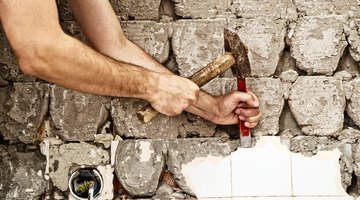How to Remove Tile Backsplash Without Damaging Drywall
When it's time to remove a tile countertop and replace it, you may hope that the demolition of the backsplash leaves the wall intact so you can paint or otherwise decorate the space. Unfortunately, if the tile was installed directly on drywall, that hope is probably unrealistic.

The adhesive bonding the tile will, at a minimum, pull the paper off the drywall, and it may pull out some of the gypsum core in places. You can try methods to minimize the damage but, in the end, you're probably going to have to do some drywall repair.
Things You Will Need
- Rotary tool
- Grout removal accessory
- Putty knife
- Hair dryer
- Gloves
- Dry ice
- Towel
- Orbital sander
- 80-grit sandpaper
- Respirator
- Goggles
Tip
Pulling the paper covering off the drywall isn't a catastrophe. You can repair the damage by skim-coating with drywall joint compound. The joint compound makes a satisfactory repair even if some of the gypsum core has come out. You need to replace drywall that has holes in it, however. If you plan to install new tile, you should glue it to cement board -- not drywall. The old drywall doesn't have to be in good condition; you simply install the cement board over it.
Warning
Wear goggles when removing grout and tiles, and when sanding glue residue. Small particles can easily get into your eyes.
-
Clean the grout out from between the tiles, using a rotary tool and a grout removal accessory. Once the grout is gone, it will be easier to pry individual tiles.
-
Insert a stiff putty knife in the gap between a pair of tiles, wedge it under one of the tiles and pry, exerting light to moderate pressure. If the tile doesn't come off, don't force it. You may be able to weaken the glue bond with heat.
-
Set a hair dryer to high, turn it on and hold it in front of the tile for about a minute. Try prying the tile. If it doesn't come, apply more heat and try prying it again. If it doesn't come on the second or third try, it's time to try a different strategy.
-
Put on protective gloves and place a piece of dry ice in a towel. Fold the towel around the dry ice and twist the ends to give you a handle. Hold the ice against the tile for a minute or two, then try prying. The extreme cold may make the glue brittle and cause the tile to come off easily.
-
Go ahead and use as much force as necessary to remove the tile if heat or cold don't loosen the glue.
-
Sand the glue residue off the wall using an orbital sander and 80-grit sandpaper. This isn't the fastest way to remove the residue, but you'll do less damage to the drywall than you would if you removed the glue with a grinder or chisel. Wear a respirator and goggles while sanding.
The Drip Cap
- When it's time to remove a tile countertop and replace it, you may hope that the demolition of the backsplash leaves the wall intact so you can paint or otherwise decorate the space.
- Insert a stiff putty knife in the gap between a pair of tiles, wedge it under one of the tiles and pry, exerting light to moderate pressure.
- If it doesn't come, apply more heat and try prying it again.
- The extreme cold may make the glue brittle and cause the tile to come off easily.
- This isn't the fastest way to remove the residue, but you'll do less damage to the drywall than you would if you removed the glue with a grinder or chisel.
References
Writer Bio
Chris Deziel has a bachelor's degree in physics and a master's degree in humanities. Besides having an abiding interest in popular science, Deziel has been active in the building and home design trades since 1975. As a landscape builder, he helped establish two gardening companies.
Photo Credits
- stevanovicigor/iStock/Getty Images
- stevanovicigor/iStock/Getty Images
More Articles


